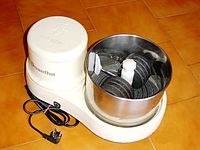Coimbatore Wet Grinder
| Coimbatore Wet Grinder | |
|---|---|
| Geographical indication | |
 Coimbatore Wet Grinder | |
| Description | wet grinders manufactured in Coimbatore |
| Type | Manufactured |
| Area | Coimbatore, Tamil Nadu |
| Country | India |
| Registered | 2005–06 |
| Material | granite, steel, electric motor |
Coimbatore Wet Grinder refers to wet grinders manufactured in Coimbatore, Tamil Nadu.[1] It has been recognized as a Geographical indication by the Government of India in 2005–06.[2] As of 2015[update], Coimbatore has more than 700 wet grinder manufacturers with a monthly output 75,000 units[3] per every 100,000 produced in India.[4]
Wet Grinder
[edit]A wet grinder is a food preparation appliance used for grinding food grains to produce batter.[5] Batter is used extensively in South Indian cuisine for preparation of popular dishes such as dosa, idly, vada, appam and paniyaram.[6][7][8][9][10] It consists of granite stones which rotate inside a metal drum with the help of an electric motor and the food grains get crushed between the stone and drum.[11]
History
[edit]P. Sabapathy developed the wet grinder in Coimbatore in 1955.[12][13][14] Sabapathy introduced the grinders to other cities such as Chennai and Madurai.[14] In 1963, P. B. Krishnamurthy started Lakshmi Grinders which led to the commercial popularity of wet grinders.[15] In 1975, R. Doraiswamy invented the tilting wet grinders.[15][16] L. G. Varadaraj introduced the table top wet grinders which replaced grinders which had to be placed on the ground.[15][17]
Industry
[edit]
As the product was invented in the city, Coimbatore naturally emerged as a center for the manufacture of wet grinders. The availability of raw material in the form of granite stones, electric motor manufacturing units and the necessary heavy equipment such as lathes, drilling and milling machines used in manufacturing aided the development of the industry.[13]
The city contributes to about 75% of the 1 lakh total monthly output of wet grinders in India.[4] The industry employs 20,000 people directly and provides indirect employment to 50,000.[13] In 2011, the cluster had a yearly turnover of ₹225 crore (US$27 million) which grew to ₹2,800 crore (US$340 million) in 2015.[4]
Recent developments
[edit]In 2007, the Government of Tamil Nadu opened a center for manufacturing raw materials for wet grinders and a research center built at a cost of ₹28.8 million (US$350,000).[18] The industry grew over ten times in the last few years due to procurement of nearly 22.5 million wet grinders by the Government of Tamil Nadu for free distribution to green family card holders.[4][19] In 2015, the Government of Puducherry announced distribution of free wet grinders to 3.37 lakh families for which it plans to procure wet grinders at a cost of ₹120 crore (US$14 million).[20]
Wet grinders are mainly sold through retail channels with the manufacturer distributing it through intermediaries. Since 2014, the sales through e-commerce channel has grown considerably helping in bulk sales and brand building.[21]
Geographical Indication
[edit]In 2005, the Government of Tamil Nadu applied for Geographical Indication for Coimbatore wet grinder.[22] The Government of India recognized it as a Geographical indication officially since the year 2005-06.[2]
References
[edit]- ^ "Industry of Coimbatore". Coimbatore Corporation. Archived from the original on 30 July 2015. Retrieved 28 June 2015.
- ^ a b "Geographical indication". Government of India. Archived from the original on 26 August 2013. Retrieved 28 June 2015.
- ^ "Wet grinder units form group to get SIDBI aid". Business Line. 24 March 2005. Retrieved 20 September 2009.
- ^ a b c d "Poll code set to hit wet grinders business". Live Mint. 6 August 2015.
- ^ Krishna Dubey (2010). The Indian Cuisine. PHI. p. 29. ISBN 9788120341708.
- ^ Farnworth, Edward R. (2003). Handbook of Fermented Functional Foods. CRC Press. ISBN 978-0-8493-1372-1.
- ^ Charmaine O' Brien (15 December 2013). The Penguin Food Guide to India. Penguin Books Limited. p. 378. ISBN 978-93-5118-575-8.
- ^ K. T. Achaya (November 2003). The Story of Our Food. Universities Press. pp. 80, 90. ISBN 978-81-7371-293-7.
- ^ P. Thankappan Nair (2004). South Indians in Kolkata. Punthi Pustak. p. 320. ISBN 978-81-86791-50-9.
- ^ Vir Sanghvi (1 January 2004). Rude Food: The Collected Food Writings of Vir Sanghvi. Penguin Books India. pp. 109–110. ISBN 978-0-14-303139-0.
- ^ "How to choose a Wet grinder". indiacurry.com. Archived from the original on 19 December 2014. Retrieved 24 January 2016.
- ^ "How a wedding gift turned into a freebie". ’’Times of India’’. 31 March 2011.
- ^ a b c Diagnostic study of the "wet grinder cluster" at Coimbatore (PDF) (Report). Development Commissioner, Ministry of Micro, Small and Medium Enterprises. Archived from the original (PDF) on 3 March 2016. Retrieved 24 January 2016.
- ^ a b "Magic of the arc lights". The Hindu. 13 July 2011.
- ^ a b c "Namma Coimbatore". The Hindu. 31 December 2013.
- ^ "Santha Grinders". santhagrinders.com. Archived from the original on 9 January 2016. Retrieved 24 January 2016.
- ^ "Coimbatore's engineering and textile industries are abuzz with activity, ending a period of slowdown". Frontline. Retrieved 24 January 2016.
- ^ "Common facility for wet grinders". The Hindu. 5 August 2007. Archived from the original on 27 October 2007. Retrieved 20 September 2009.
- ^ "Tamil Nadu, the ultimate freebie state". The Hindu. 30 March 2015.
- ^ "Over four years after it made a promise, AINRC government launches freebies scheme in Puducherry". The Hindu. 25 August 2015.
- ^ "e-commerce makes inroads in Coimbatore manufacturing activities". The Hindu. 22 June 2015.
- ^ "GI tag: TN trails Karnataka with 18 products". Times of India. 29 August 2013.

